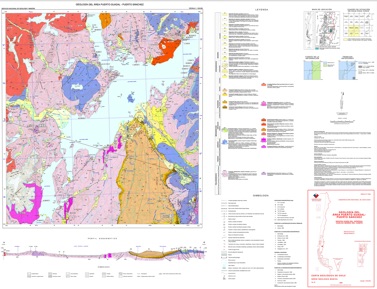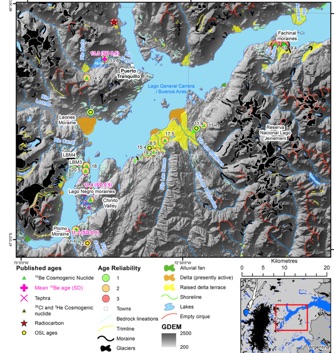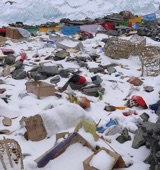The terraces:
13,000 years ago, Lago General Carrera was 450 metres above present level of 201 m asl; Photos
It drained in seven steps - the delta from each level is now visible as a terrace;
In the Leones valley, the last three levels are visible close to the lake at 320 m, 420 m and 450 m asl.
The icefields in Chile's Patagonia are melting
at some of the fastest rates on the planet:
This glacier melts (thickness) 6 cm/day in summer
and 1cm/day in winter at 1300 m altitude.
The terminal moraines: the boulders at Lago General
Carrera are 11,300+/-600 years old, and the one at
Lago Leones are 1,000- 2,500 old (see papers below).
Glacier Leones almost dissapeared: https://rutaleon.info
El fraude científico, una lacra creciente que amenaza la integridad de la investigación, un fenómeno más extendido de lo que pensamos:
El mundo de la investigación científica se enfrenta a un problema creciente de fraude y mala conducta, que ponen en peligro la fiabilidad del conocimiento producido. No tenemos idea del volumen en el que la gente, visiblemente, puede haber fabricado o falsificado datos, o plagiado. Las revistas depredadoras, que imitan el proceso científico, prosperan. Los fraudes son también presentes en revistas influyentes. El sistema incluye: un nuevo tipo de fraude, un descubrimiento oportunista y la producción de datos por la inteligencia artificial (IA). Se observa un aumento exponencial de artículos retractados. Un artículo es, probablemente, fraudulento si presenta “expresiones torturadas”. Un sistema a repensar.
Una Revisión de los tipos de Fraude Científico más Frecuentes
La investigación geológica (evaluación del volumen de los recursos hídricos) implica el desarrollo de la minería, en particular la extracción de glaciares y del agua del área, lo que agota los recursos hídricos de los biotopos en restauración.
Sobre la base de este estudio de caso y el hecho de que la comunidad científica ignora con frecuencia el estatus legal del terreno que estudia, investigaciones geológicas, de geoconservación y otras de materia inerte seguramente no son aceptadas en el proyecto. Los glaciares son vendidos a través de la comunidad científica.

Responsabilidad ambiental y social corporativa de la geoinvestigación
Geological research (assessment of volume of water resources) implies further mining, in particular mining of glaciers and water in the area, thus depleting water resources of the biotopes under restoration.
Underground aquifers comprise 97 % of the world’s accessible water.
On the basis of the above-mentioned case study and the fact that the scientific community tends to ignore legal status of the land it studies, in order to prevent damage to live Nature from research of inert abiotic factors, potential researchers are asked to observe national laws, in this case - property laws, protecting a conservation and ecosystem restoration project, and seek prior explicit advice of and agreement with landowners. As a general rule geology, geomorphology and other inert matter’s research is not accepted in the project. Publications are listed taking into consideration caveats re: scientific investigations
Local geomorphology, some facts:
-
‣ The ice caps reached their tipping points.
-
‣ The area is undergoing a radical transformation of landscapes.
-
‣ Glaciers in Patagonia could melt suddenly as they did in the last interglacial.
-
‣ The Patagonian ice fields are not UNESCO World Heritage glaciers.
-
‣ The geographic name of the river flowing out of the lake Leones is Rio Delta.
Its water network is not in vector form but as areas.
-
‣ In the anthropocene inert matter (geomorphology and its evolution) does not influence life as previously.
-
‣ The valley is a geologically young valley.
-
‣ Located on the South American tectonic plate, South of Chile ridge, therefore not affected by the Nazca plate too much.
-
‣ Climate change alters the geomorphology of the area, awakes dormant faults an triggers eruptions.
-
‣ The rebound of the melting icefield influences the seismic tectonic balance of the area (induced seismicity).
-
‣ Black carbon pollution from tourism and research increasing Antarctic snowmelt.
-
‣ Los glaciares de la Patagonia se están retirando más rápido que en cualquier otro lugar.
-
‣ Patagonia’s ice fields account for 83 percent of all ice loss in South America.
La próxima pandemia podría provenir del deshielo de los glaciares
Next pandemic may come from melting glaciers, new data shows
Moraine collapse:
The moraine containing the lake below glacier Calafate (Leones valley) collapsed in 2001;
More than 2 million cubic meters of soil and rock material from it cover approximately 40 ha;
Some rocks are 10 metres high;
The soil cover and the biotope are very fragile. Calafate GLOF.
The valley:
Northern icefield monitoring in the Project , since 2010;
Expeditions in the valley: The 40th anniversary of: The “New Zealand Patagonian Expedition 1969 ;
Tararua Patagonian Expedition 1969-70.pdf ;
Glaciar León, Chilean Patagonia: late-Holocene chronology and geomorphology ;
25 kyr luminescence date for a terminal moraine in the Leones valley .pdf ;
North Leones Glacier Retreat and new Landslide, Patagonia, Chile ; Dangers of lake failures in Patagonia ;
The timing and nature of recession of outlet glaciers of Hielo Patagonico Norte, Chile ;
Holocene glaciations of Hielo Patagónico (Patagonia Icefield).pdf ; Recent mountain glacier retreat ;
Local glaciers’ melting:
When visiting or studying a glacier we seriously contribute to its melting.
Global ice loss accelerating at record rate
Seismic study reveals key reason why Patagonia is rising as glaciers melt
The evolution of the Patagonian Ice Sheet from 35 ka to the present day (PATICE) ;
Glaciers in Chile 'melt at fastest rate in 350 years' ; Shrinking Patagonian Glaciers ;
Patagonia glacial retreat.pdf ; Rapid thinning of the late Patagonian Ice Sheet.pdf ;
Northern Patagonian Icefield.pdf ; Some glaciers may already be functionally extinct ;
Glacier fluctuations in extratropical South America during the past 1000 years.pdf ;
Ice elevation and areal changes of glaciers from the Northern Patagonia Icefield, Chile.pdf ;
The Patagonian Ice Sheet Melting beauty: The Patagonian icefields
GLIMS, Monitoring the World's Changing Glaciers: www.glims.org
The area:
1991 eruptions of Cerro Hudson, Chile.pdf ; The Andes: Lost tectonic history recovered from Earth’s deep mantle ;
Quaternary lacustrine braid deltas on Lake General Carrera in southern Chile.pdf ; Andes meltdown .
Cold desertification of the area, cryo-expulsion, soil destructurisation : Degradation ; Soil .
Exportacion de agua:
La compania que exporta el agua de los acuíferos del valle Leones, es Glacier Waters International o Patagonian Glacier Waters, a traves de Alma Patagonia glacier water, registrada en Panama. Si una empresa está registrada en Panamá, las autoridades de otros países no pueden investigar, no hay recurso. El agua es un recurso valioso. Las comunidades locales no son reconocidas ni recompensadas por sus servicios, los servicios ecosistémicos no son pagados a la comunidad inmediata.
Alma Water Patagonia: located in Leones valley, no ecosystem services paid to the community, local communities not recognised or rewarded for the services.


Inert matter: all substances of the biosphere, in the creation of which living organisms do not participate.
The project is working with rights of living nature matter, not inert matter: if it is not alive, it does not have too much value.
At present, the anthropogenic transformation of matter on Earth is vectoring from living matter into inert matter, which will never be returned to life. The amount of man-made materials exceed the amount of living biomass on Earth, therefore the former is well placed to protect itself.

Materia inerte: todas las sustancias de la biosfera, en la creación de las cuales los organismos vivos no participan.
Uno de los objetivos del proyecto es adaptar las normas jurídicas existentes para proteger la naturaleza viva
y combatir la crisis actual de responsabilidad.
Protecting live biomass from science’s obsession by inert matter.
Un ejemplo de daños y perjuicios legales resultantes del privilegio de la investigación de la materia inerte sobre los derechos de la naturaleza viva:
Los estudios recientes en la geomorfología, de “geoconservación” del vaciamiento del lago Mapuche , o Calafate (40 ha del vaciamiento y la mitad de las fotos del "geositio" están ubicadas en terreno privado no abierto al público y albergando un ecosistema frágil), realizados en una propiedad privada sin ningún acuerdo del propietario, donde cualquier investigación científica de este tipo está prohibida por acuerdos del Derecho Real de Conservación (Ley Nº20.930) entre otros, y su consiguiente publicación, produjeron las consecuencias perjudiciales para todas las partes:
-
• Responsabilidad de los investigadores y de la institución mandante por la vulneración del proyecto de proteccion de la naturaleza, infracción de los derechos de este proyecto, uso fraudulento de propiedad ajena;
-
• Incumplimiento de la obligación de celebrar un acuerdo formal y explícito con el propietario y/o el custodio, ya sea público o privado, que cubra cuestiones como la propiedad intelectual, la remuneración, las condiciones de uso del terreno y de los resultados, las medidas de protección del medio ambiente, las cuestiones de compensación y restauración,modalidades de publicación de los resultados científicos, responsabilidades respectivas, etc. la propiedad intelectual debe haber permanecido en manos de los propietarios de las tierras (privadas y públicas) de conformidad con un contrato debidamente elaborado;
-
• Promoción, por los investigadores, del uso publico del terreno, no autorizado por los custodios (turismo y investigación invasiva), mediante la publicación de los hallazgos en total contradicción con el objetivo del proyecto, lo que significa “enajenación de bienes ajenos sin su conocimiento y contra su voluntad”, un agravio clásico del derecho civil.
-
• Promoción del acceso público a las propiedades privadas de un proyecto de conservación de la naturaleza viva, donde no existen servidumbres de paso o acceso público - daño directo e indirecto a las areas naturales protegidas;
-
• Contribución a arruinar la biodiversidad frágil del área (daño ambiental) por la exposición degradante del área la más sensible y con mayor biodiversidad del proyecto;
-
• Responsabilidad legal general de los investigadores por los agravios citados de diferentes ramas de derecho, principalmente derecho civil, inmobiliario y ambiental, así como responsabilidad por la ausencia concurrente de cualquier beneficio (como servicios ecosistemicos) para el proyecto asegurando los derechos de la naturaleza viva, o para los terratenientes campesinos del valle;
-
• Turismo o investigaciones científicos: cualquier autorización de una actividad externa que utilice el recurso compartido (entre propietarios) requerirá su acuerdo común, por separado o en conjunto, registrado de manera legalmente aceptable;
-
• Mas importante: la mayor parte del “geositio” se encuentra en el parque nacional Laguna San Rafael, área protegida del Estado. La información obtenida en un parque nacional sin observar la normativa para este tipo de investigaciones.: Permiso de investigación en áreas silvestres protegidas
Reglamento sobre Filmaciones y Captura de Imágenes en Áreas Silvestres Protegidas
Para que sean válidos los resultados deben obtenerse de forma legal;
-
• No se tuvo en cuenta a la comunidad local. El vínculo entre las comunidades locales y las áreas protegidas fue ignorado;
-
• La investigación fue realizada por un pasante del CIEP de la SEREMI de la minería, lo que la convierte en un proyecto de la industria minera, similar al proyecto del Geoparque a continuación; Felipe Andrade, geólogo y coordinador del proyecto geoparque Chelenko
El Sernageomin no tiene derecho a acceder a propiedades privadas para estudios geológicos non mineros. Debe hacerle con la autorización explícita y registrada del propietario del terreno. La autorización sera limitada solo a las actividades que revele la autoridad y respetando las condiciones que el propietario crea convenientes.


Basura en el glaciar de la zona


Actualmente, la materia inerte creada por el hombre se ha convertido en una parte importante de la geomorfología, por ejemplo el plástico, presente en todos los ecosistemas del mundo.
